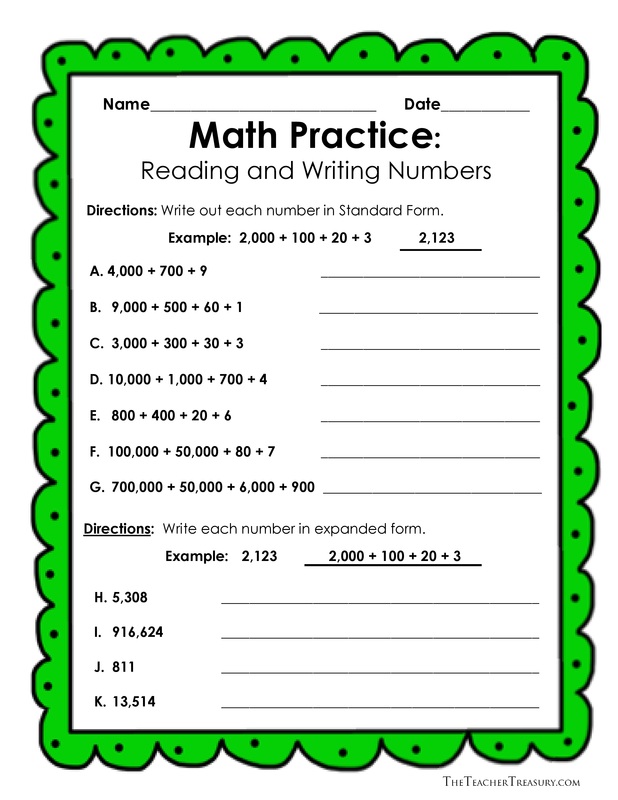How do I write numbers in the different number system?
Read, write and use numbers, using the principle of place value, in the Hindu-Arabic system of numeration.
CONTENT SUMMARY:
We can also write decimals using standard notation.
For example, if our number were 236.82, expanded form and notation would look like this:
200 + 30 + 6 + 0.8 + 0.02 = 236.82
(2 x 100) + (3 x 10) + (6 x 1) + (8 x 1/10) + (2 x 1/100) = 236.82
ENGAGE
1. 1. Write standard numerals for the following:
(a) 40,000 + 9000 + 200 + 60 + 7 = (b) 1,000,000 + 600 + 40 + 2 =
2. 2. Write the following whole numbers in expanded form:
(a) 5,768,965 (b) 786, 944 (c) 32,564, 345
3. 3. Write the highest and smallest number from the following: [78946]
4. 4. What is the highest number that can be formed from 81942, using 9 in the tens place and 4 in the thousands place?
5. What number is represented on the chart below?
(A) 2815.17 (B) 2725.17 (C) 2626.17 (D) 2617.17

Lesson Plan Overview
-
Grade: 6
-
Duration: 1 hour
-
Theme: Numbers – Expanded and Standard Form
-
Focus Question: How do I write numbers in the different number system?
-
Subtopic: Writing numbers in expanded and standard form
-
Numeration System: Hindu-Arabic
-
Objective:
Students will: -
Read, write, and use numbers, using the principle of place value in the Hindu-Arabic system of numeration.
-
Convert between expanded form and standard form.
-
Explain how place value determines the value of each digit.
Materials Needed:
Digit cards (0–9)
Place value charts/ mats
Base ten blocks (real or virtual)
Whiteboards/markers
Printable worksheets, teachers' blogsite
Devices (optional – for STEM tools)
- Projector, chromebooks
🧠 Engage (5–7 minutes)
Activity: "Digit Drama!"
-
Write the number 70,408 on the board.
-
Ask:
-
"Can you tell me the value of each digit?"
-
"What does the 7 represent in this number?"
-
-
Use questioning to spark curiosity:
-
"What happens when I move the 7 from the ten-thousands place to the hundreds place?" (Write: 400,708 vs. 708)
-
Purpose:
To activate prior knowledge on place value and set the stage for expanded/standard form conversion.
🔍 Explore (10–12 minutes)
Activity: "Build a Number – Place Value Flip Cards"
-
Provide students with digit cards (0–9) and place value headings: Millions, Hundred Thousands, Ten Thousands, Thousands, Hundreds, Tens, Ones.
-
In pairs or small groups, have students:
-
Randomly select digits and build a 6-digit number.
-
Write the expanded form on mini whiteboards or chart paper.
-
Share with the class: e.g., 543,210 → 500,000 + 40,000 + 3,000 + 200 + 10
-
STEM Integration:
-
Technology Option: Use an online place value interactive tool (if available) like Didax Virtual Place Value Disks for digital modeling.
-
Engineering Connection: Ask: “How do engineers use numbers in different forms—for measuring, costing, or scaling?”
📘 Explain (10–12 minutes)
Teacher Input:
-
Define standard form and expanded form using anchor charts:
-
Standard Form: The usual way of writing numbers (e.g., 76,032)
-
Expanded Form: Breaking down the value of each digit based on place value (e.g., 70,000 + 6,000 + 0 + 30 + 2)
-
Guided Practice:
-
Model converting:
-
From standard to expanded: 609,004 → 600,000 + 0 + 9,000 + 0 + 0 + 4
-
From expanded to standard: 400,000 + 30,000 + 700 + 2 → 430,702
-
🧠 Elaborate (15 minutes)
Differentiated Activity: "Number Transformation Stations"
Split students into three ability-based groups (can rotate if time allows):
| Tier | Group Name | Task |
|---|---|---|
| Tier 1 (Support) | Place Value Pals | Use base ten blocks/diagrams and teacher support to convert 3-digit and 4-digit numbers between expanded and standard form. |
| Tier 2 (On-level) | Number Ninjas | Convert between 5–6 digit numbers in both directions. Use place value charts. |
| Tier 3 (Extension) | Number Architects | Solve real-life word problems involving population, distance, or cost with large numbers. Convert between expanded and standard forms as part of the explanation. |
Real-World/ STEM Twist:
-
Students use a mock engineering budget:
E.g., “You are building a bridge. Your material costs $245,300. Break it into expanded form to explain how much you’re spending per material type.”
✅ Evaluate (10 minutes)
Three-Tier Evaluation Activity:
| Level | Activity | Expected Outcome |
|---|---|---|
| Tier 1 (Basic) | Students convert 3 given numbers between standard and expanded form (up to 4 digits). | At least 2 out of 3 correct conversions. |
| Tier 2 (Proficient) | Students complete a short worksheet with 6 conversions (4-digit and 5-digit numbers) in both directions. | 5 or more correct. |
| Tier 3 (Advanced) | Students are given a word problem: “You’re managing a budget of 1,206,850. Break it down in expanded form and justify your breakdown.” | Logical explanation and accurate expanded form. |
🏁 Extend (Homework/Enrichment)
-
Students research how different number systems (e.g., Roman Numerals or Binary Code) represent the number 365.
-
Optional: Create a poster comparing expanded form vs. Roman numerals.



Hi miss
ReplyDelete